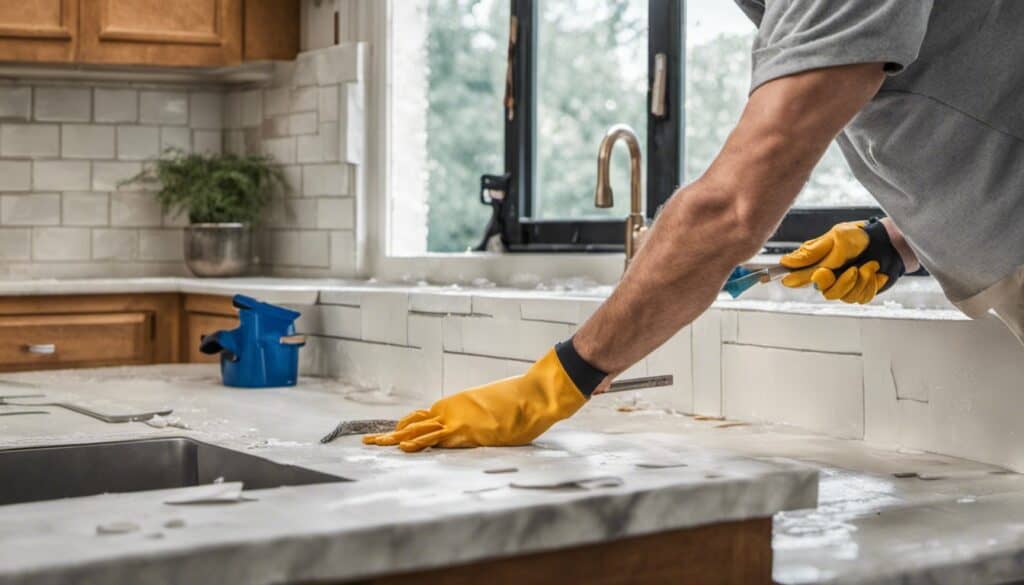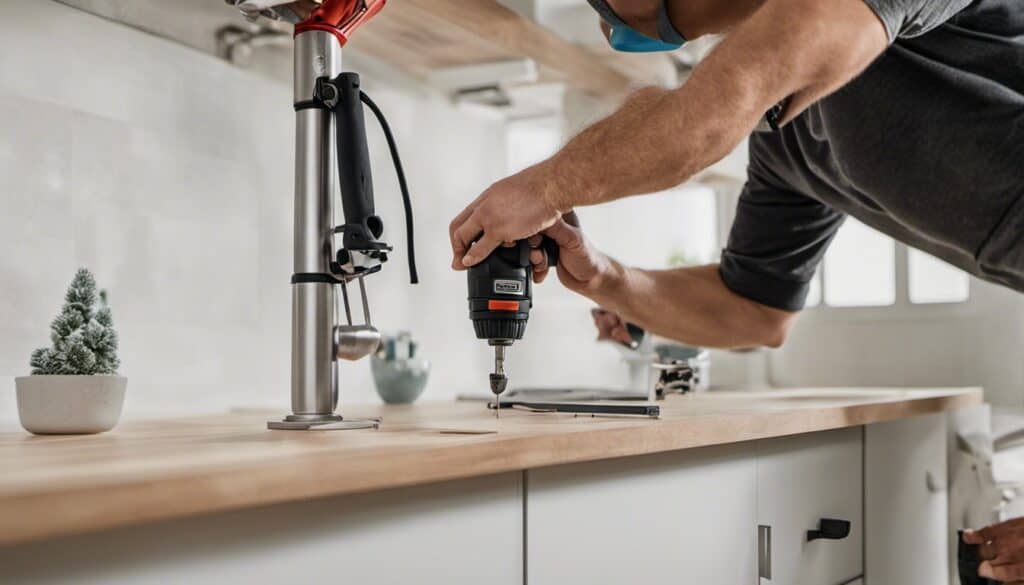So you want to remove granite countertops without breaking them, huh? Don’t worry, you’re not alone. Granite countertops have been the gold standard for kitchens and bathrooms for quite some time, but sometimes a change is in order. Whether you’re in the mood for a remodeling project or just thinking of upgrading to a different material, you’ll want to make sure that you can successfully remove your existing granite without causing any damage.
The good news is that removing granite countertops is possible, especially with proper care and the right set of tools. The first thing to understand is that granite countertops are heavy and awkward to maneuver. This means that the process of removing them can be a bit tricky if you’re not prepared, and that’s why it’s important to gather all the necessary tools beforehand.
To help you tackle this home improvement project, we’re going to go over some key steps on how to remove granite countertops safely and efficiently. By following these guidelines, you’ll be on your way to having a brand-new countertop without any damage to your cabinets or the granite itself. Get ready; you’re about to embark on a journey that will transform your kitchen or bathroom!
Reasons to Remove Granite Countertops
So, you’ve got granite countertops in your kitchen, and they’ve been serving you well. Granite is known for its durability and can definitely take a fair share of wear and tear. However, there comes a time when you might want to let go of your old granite countertops in favor of a fresh new look or sometimes due to unavoidable circumstances like damage. Let’s delve into a few reasons why you could consider removing your granite countertops.
First off, the aesthetic of your kitchen might be calling for a change. Your once dazzling granite countertops might have lost their shine over the years, and giving your kitchen a makeover could involve a countertop replacement. Switching to a different material, like quartz or marble, can completely transform the look of your kitchen and give it a much-needed breath of fresh air.
Another reason for a potential removal might be the damage done to your countertops. Even with granite’s impressive strength and resistance to heat and scratches, time can take its toll. Maybe your countertops have acquired some noticeable stains, cracks, or chips that need fixing. If the damage is extensive, repairing it might not be an option, and removal could be the way to go.
Sometimes, it’s all about functionality. As your kitchen needs change over the years, so does the functionality you require from your countertops. Perhaps you need more counter space, or maybe you want to incorporate an island with extra cabinets – removing the old granite countertops could provide an opportunity to reconfigure the kitchen layout and design.
Finally, you might be all about playing your part for the environment. Removing granite countertops carefully and without breaking them means giving them a new lease on life. Rather than ending up in a landfill, these countertops can be repurposed and used elsewhere in your home or donated to a secondhand building supply store, promoting sustainability and reducing waste.
So, it’s clear that there are various reasons why you might want to remove your granite countertops. Just remember to weigh your options carefully and ensure that you’re handling the removal and replacement process in a way that’s best suited for your situation and the environment.
Preparations for Removal
So, you’ve decided to remove your granite countertops without breaking them, huh? That’s fantastic! Before you dive in headfirst, it’s crucial to prepare yourself and your workspace to ensure everything runs smoothly. Don’t worry, we’ve got your back!
First things first, gather your essential tools. You’ll need a putty knife, box cutter or thin blade, a pry bar, a reciprocating saw (for particularly heavy countertops), and some caulk softener for those stubborn spots. With all your tools assembled, you’re one step closer to tackling this project like a pro.
Now, let’s clear the area. Nobody wants a mess, right? Start by disconnecting the water lines running to your sink and faucets. Also, consider turning off the water supply just to be on the safe side. Once that’s done, go ahead and remove the faucets and the sink. You’d be surprised how quickly things can spiral out of control if they’re left hanging around. Trust us on this one.
With everything removed and waterlines safely disconnected, your workspace is in tip-top shape! You’re now ready to start the removal process. Remember, keep it cool and calm and go slow; haste and granite removal don’t mix well. Just take your time, and those countertops will be out of there before you know it. Good luck!
Removing the Backsplash

Removing the backsplash without causing damage can seem like a daunting task, but don’t worry, it’s doable! Just follow these simple steps and you’ll have that old backsplash out in no time, without a scratch.
First things first, you’ll need a pry bar to help you out. Now, before you start, locate the topmost edge of the backsplash where it meets the wall. This is where you’ll want to start your prying efforts. Gently wedge the pry bar in the gap between the backsplash and the wall, taking extra care not to damage the walls or the edge of the backsplash.
Once you’ve got the pry bar in place, it’s time to break the caulk seal. Use a gentle rocking motion with the pry bar to slowly break the caulk seal holding the backsplash to the wall. Remember, slow and steady wins the race here – you don’t want to rush and end up breaking the backsplash or damaging the wall.
As you make progress, continue working your way along the edge of the backsplash, prying bit by bit. You’ll notice the backsplash starting to loosen up. Patience is key here, and eventually, the whole thing will come off.
Now that you’ve successfully removed the backsplash, the old countertop is just waiting to be replaced. You’ve come this far, and now you’re one step closer to that granite countertop upgrade! Just remember to take your time, follow the steps, and keep that casual can-do attitude. Good luck!
Lifting the Granite Countertop
So, you’re ready to lift the granite countertop without damaging it or the cabinets below? No worries! Let’s dive right in. When lifting the countertop, it’s crucial to be gentle and patient to avoid any unfortunate accidents. We’ll go through the steps here so you can safely remove your beautiful granite slab and keep it intact.
First things first, you’ll want to prepare your tools. Some essentials you’ll need include a utility knife, pry bar, putty knife, suction cups with handles, and some wood or composite wedge shims. Make sure you have all these tools on hand before you begin the process. Trust us, it’ll make everything go much smoother.
Now you’re ready to start. Heat can be your best friend in this process. Use a hairdryer or heat gun to gently apply heat to the area where the countertop is glued to the cabinet. Just focus on one end of the countertop and heat it for about 2-3 minutes. This will help soften the adhesive connecting the granite to the cabinet.
Once the adhesive is loosened up a bit, use your putty knife to carefully slide it under the heated end of the countertop. This should cause the countertop to slightly lift. Repeat this process along the entire length of the countertop until the entire slab is raised and resting on the shims you’ve placed beneath.
Now that the granite slab is lifted, it’s time for the fun part! Attach the suction cups with handles to the countertop’s surface. This will give you the necessary grip to safely remove the slab without risking any damage to you or the granite. You should have someone to help you lift the granite countertop, as they can be quite hefty. Work together and lift the counter evenly and slowly—you don’t want to rush this delicate process.
And voilà! By following these steps, you’ve successfully lifted the granite countertop without causing damage to the slab, the cabinets, or yourself. So, give yourself a pat on the back, and take pride in your newfound granite-lifting skills!
Separating Granite and Plywood
So you’ve decided to remove your granite countertops but want to keep them intact. No worries! We’ve got some handy tips to help you do just that. One crucial step is separating the granite from the plywood underneath. Let’s dive into how you can achieve that, shall we?
First things first, grab a putty knife. A nice, thin, flexible one will do the trick. You’ll be using this nifty tool to carefully break through the adhesive layer that holds the plywood and granite together. It’s essential to be patient and gentle during this process to avoid any damage to the granite.
Now, with your putty knife in hand, start at one end of the countertop, gently sliding it between the granite and plywood. Use a bit of force, but not too much! You want to avoid any unnecessary damage, remember? Slowly work your way along the length of the countertop, gently prying apart the two layers.
You may come across stubborn spots where the adhesive is thicker or has a stronger hold. Don’t panic! Just take a deep breath, and work your putty knife back and forth in that area, gradually breaking through the adhesive. Patience, my friend, patience!
Once you’ve successfully separated the granite from the plywood, you’ll want to remove the plywood. This part can be a bit tricky, but you’ve got this! Make sure all screws or fasteners attaching the plywood to the cabinets are removed before attempting to lift it.
Finally, it’s time to remove your granite countertops in one piece! Get some help from a friend or family member for this part, as granite can be pretty heavy. Gently lift the granite off the cabinets, taking care not to damage any edges or corners.
And there you have it! Now you’ve got your granite countertops removed without breaking them! Best of luck with your next project, and remember to keep things casual and lighthearted!
Proper Handling of Removed Granite
So, you’ve decided to remove your granite countertops without breaking them, eh? Smart move, my friend! Granite is an exquisite natural stone that can add a touch of luxury to any space. Now, let’s dive into the proper handling of removed granite slabs to ensure their flawless beauty remains intact while they find a new home in your space.
First things first, always treat your granite countertops with care and respect. After all, this is one of nature’s finest creations we’re talking about! When you’re moving the granite countertop slabs, be sure to carry them flat to evenly distribute their weight. This helps avoid potential cracks or breaks that can occur if the slab bends or warps.
You might want to enlist the help of some friends or family to assist with the heavy lifting. It’s no secret that granite is heavy stuff, so it’s better to be safe than sorry! Grab a buddy or two, and work together to ensure the slab remains flat and well-supported during the move. Teamwork makes the dream work, right?
Also, don’t forget to protect the edges of your granite countertops while you’re at it! Slabs of granite can have delicate and sharp edges, so wrap them with bubble wrap, moving blankets, or other cushioning materials to shield them from damage and keep everyone involved safe from harm.
When it comes to storage, keep your removed granite countertops in a cool, dry place, away from direct sunlight or extreme temperature fluctuations. If you’re planning to reinstall the slabs later, it’s essential to keep them in tip-top shape during their time in storage.
Remember, by taking the time to handle your granite countertops with care, you’re preserving the stunning beauty and elegance of these natural stone gems. And who wouldn’t want flawless granite slabs gracing their home? Follow these steps, and you’ll be well on your way to reclaiming your space while keeping the gorgeousness of your granite intact!
Reinstalling the New Countertop

Now that you’ve successfully removed your old granite countertop, it’s time to reinstall the new one. Whether you’re switching to a fresh granite countertop or exploring different materials like quartz, here’s a rundown on how to get the job done.
First, ensure that your cabinets are prepped and ready. Check that they’re leveled, clean, and sturdy enough to support your new countertop. Next, measure your space and make sure the new countertop fits precisely. If not, you’ll need to make adjustments or trim the material.
When you have the perfect fit, it’s time to move on to installation. Grab a buddy or two because you’ll need some help carrying and positioning the countertop. You wouldn’t want to risk damaging it – or your back – right?
Now that you’ve got some pals holding onto the countertop, you can mix up the adhesive that’ll keep everything in place. Read the instructions provided by the manufacturer and apply the adhesive to the edges of the cabinets where the countertop will rest.
Alright, the moment of truth! Gently lower the countertop onto the cabinets, making sure it’s aligned and resting on the adhesive. Use a soft mallet or a rubber hammer to gently tap and nudge the material into position if needed. Make sure you don’t apply too much force, which might crack or chip the countertop.
With the countertop in place, you’ll want to secure it further with brackets or braces, especially if there’s an overhang or unsupported sections. Follow the manufacturer’s recommendations on how to do this to ensure your new countertop stays put.
Sinks, cooktops, and other appliances or features should be cut out and installed according to their instructions. Make sure to keep the cut-out sections of the countertop if they’re large enough to be used as matching cutting boards or trivets.
Once everything is in place and looking fantastic, give yourself a pat on the back! You’ve completed the challenging task of reinstalling a new countertop, and your kitchen looks stunning. Enjoy your upgraded space, and go ahead, brag about it to friends and family – you deserve it!
